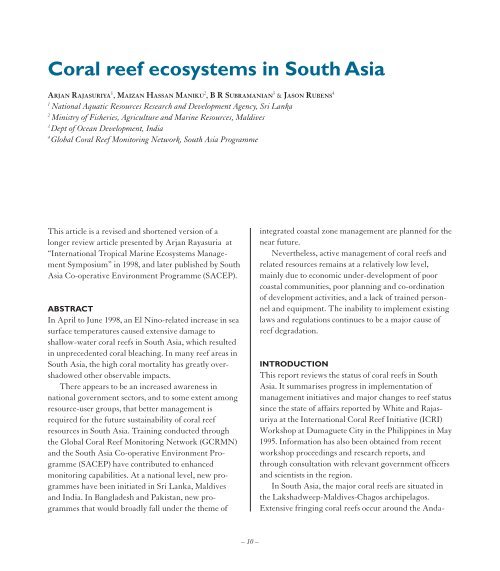Create successful ePaper yourself
Turn your PDF publications into a flip-book with our unique Google optimized e-Paper software.
Coral reef ecosystems in South Asia<br />
ARJAN RAJASURIYA 1 , MAIZAN HASSAN MANIKU 2 , B R SUBRAMANIAN 3 & JASON RUBENS 4<br />
1<br />
National Aquatic Resources Research and Development Agency, Sri Lanka<br />
2<br />
Ministry of Fisheries, Agriculture and Marine Resources, Maldives<br />
3<br />
Dept of Ocean Development, India<br />
4<br />
Global Coral Reef Monitoring Network, South Asia Programme<br />
This article is a revised and shortened version of a<br />
longer review article presented by Arjan Rayasuria at<br />
‘‘International Tropical Marine Ecosystems Management<br />
Symposium” in 1998, and later published by South<br />
Asia Co-operative Environment Programme (SACEP).<br />
ABSTRACT<br />
In April to June 1998, an El Nino-related increase in sea<br />
surface temperatures caused extensive damage to<br />
shallow-water coral reefs in South Asia, which resulted<br />
in unprecedented coral bleaching. In many reef areas in<br />
South Asia, the high coral mortality has greatly overshadowed<br />
other observable impacts.<br />
There appears to be an increased awareness in<br />
national government sectors, and to some extent among<br />
resource-user groups, that better management is<br />
required for the future sustainability of coral reef<br />
resources in South Asia. Training conducted through<br />
the Global Coral Reef Monitoring Network (GCRMN)<br />
and the South Asia Co-operative Environment Programme<br />
(SACEP) have contributed to enhanced<br />
monitoring capabilities. At a national level, new programmes<br />
have been initiated in Sri Lanka, Maldives<br />
and India. In Bangladesh and Pakistan, new programmes<br />
that would broadly fall under the theme of<br />
integrated coastal zone management are planned for the<br />
near future.<br />
Nevertheless, active management of coral reefs and<br />
related resources remains at a relatively low level,<br />
mainly due to economic under-development of poor<br />
coastal communities, poor planning and co-ordination<br />
of development activities, and a lack of trained personnel<br />
and equipment. The inability to implement existing<br />
laws and regulations continues to be a major cause of<br />
reef degradation.<br />
INTRODUCTION<br />
This report reviews the status of coral reefs in South<br />
Asia. It summarises progress in implementation of<br />
management initiatives and major changes to reef status<br />
since the state of affairs reported by White and Rajasuriya<br />
at the International Coral Reef Initiative (ICRI)<br />
Workshop at Dumaguete City in the Philippines in May<br />
1995. Information has also been obtained from recent<br />
workshop proceedings and research reports, and<br />
through consultation with relevant government officers<br />
and scientists in the region.<br />
In South Asia, the major coral reefs are situated in<br />
the Lakshadweep-Maldives-Chagos archipelagos.<br />
Extensive fringing coral reefs occur around the Anda-<br />
– 10 –


















